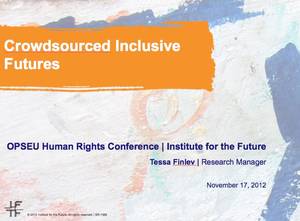Future Now
The IFTF Blog
Crowdsourced Inclusive Futures
Last November I was invited to speak to the Ontario Public Service Employees Union (OPSEU) at their second biannual Human Rights Conference about crowdsourcing inclusive futures.

The focus of the conference was on social media and social change. OPSEU is figuring out how union members can use social media to enhance their own work. After a successful and exciting run at the Catalysts for Change game last April, OPSEU asked us to come and share our experience of running an online game focused on social change.
I took the opportunity to share some of our wider research on how the internet is being used to build a world of inclusion that makes space for a multiplicity of ideas, beliefs, and voices, and by extension has the potential to build a more peaceful world.
The social internet has allowed us to build new capacities for inclusion and diversity of voice through the development of three particularly effective social change tools.
Data Overload:
Previously the domain of economists, demographics, and other experts, data is quickly becoming the force behind citizen driven social change.
How do we make data digestible, accessible, and actionable for social change agents?
Organizations like Nigeria's BudgIT are a prime example of this story.
Collaboration and participation:
Holding massively collaborative conversations and running massively participatory projects has in the past been near impossible. Today we can gather voices from around the world and across disciplines and experiences in order to elicit new solutions and perspectives to age old challenges.
How do we use the tools of the internet to enhance our collaborative and participatory efforts?
Catalysts for Change brought over 1600 people together across 79 countries to brainstorm new paths out of poverty over the next decade.
Mapping:
Mapping—particularly the power dynamics between who maps which communities and to what end—has long been a focus of social change. Today mapping has not just become democratized, but new tools are allowing us to map our own communities in new ways to unearth new meanings.
What does social change look like when we begin to combine physical place with emotion mapping and augmented reality? Imagine the power of a virtual Tahrir Square.
Although still very emergent, new tools like the Shippo Tail, the Scanadu SCOUT, and Affdex can be combined with augmented reality and remained to design holistic mapping and organizing tools.
Opposing forces at play:
Unfortunately there are also opposing forces at play. The weaponization of social media—as my colleague Jamais Casio calls it—and the filter bubble both pose potential challenges to social change agents of the future.
The social internet is in the midsts of continuous transformation. It is up to us to decide if we want to build an internet based on inclusion, or fragmentation. Both forces are at play, and the future is yet to be written.
How will you use the internet?
To continue this exciting conversation email me at tfinlev@iftf.org



